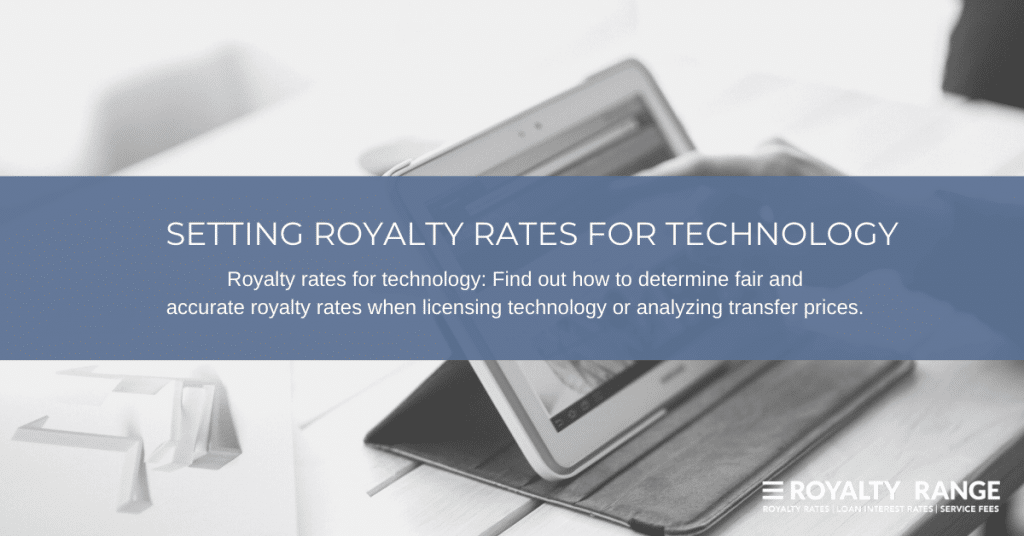Setting royalty rates for technology

Kris (Kestutis) Rudzika |
January 14, 2020

To determine royalty rates for technology, you need to know the market value of the intellectual property you’re licensing and use comparable license agreements as a starting point for your analysis. Royalty rates are usually set as a percentage of revenue generated by the technology, so the royalties are calculated by applying the royalty percentage to the gross or net sales. In this article, we’ll look at the different factors of setting technology licensing royalty rates, including intellectual property valuation, different calculation methods and using comparable market data.
Finding the market value of technology
Before you can set royalty rates for your technology, you need to determine its market value. Only then can you be sure that the royalties you set are fair and in line with market rates. Technology contains intellectual property like patents and know how, so your valuation needs to reflect this.
There are three main intellectual property valuation approaches you can use for your technology:
- A cost-based approach: Cost-based approaches base the asset’s value on the cost of developing it. The two main cost-based methods of intellectual property valuation are the reproduction cost method and the replacement cost method.
- A market-based approach: With a market-based approach, you estimate the value of the intellectual property by comparing it with the value assigned to comparable intellectual property in similar market transactions. You can find data on comparable license agreements in specialist royalty rates databases like RoyaltyRange.
- An income-based approach: This approach values an intangible asset through the income it is expected to generate. The two main income-based methods for the valuation of intangibles are the discounted cash flow method and the relief from royalty method.
Setting royalty rates for technology
Once you know the market value of the technology being licensed, you can move on to setting royalty rates. These are negotiated between the licensor and licensee and outlined in the technology licensing agreement. Knowing the market rates for similar transactions is an important starting point for setting accurate royalty rates, and can also strengthen your negotiating position by providing proof of what other organizations are charging for similar technology licensing deals.
You can use a market approach to set royalty rates for technology. To do so, you will need to identify similar transactions involving comparable intellectual property, which you can use as a basis for your analysis. Technology is often unique because of the intellectual property it contains, but you can use license agreements with comparable terms – for example, exclusivity, date, territory, industry, market size, market potential and remuneration (e.g. were upfront fees paid?).
It’s important to remember that the stage and strength of the intellectual property will significantly affect what royalty rates can reasonably be charged. For example, if the technology has significant market commercialization, the royalty rates will likely be higher. Or, if the market being licensed into is competitive, this may affect the strength of the intellectual property and the royalty rates.
You can find comparable royalty rates for technology by using our One Search service. You’ll get a bespoke report of relevant license agreements from our database, based on your search criteria.
Technology licensing royalty rates
If you are analyzing a transaction where technology rights have been transferred between related company entities, you will need to establish arm’s length technology transfer royalty rates.
The fee for transferring a company’s intellectual property rights to a subsidiary or associated entity should be the same as it would have been had the transaction occurred between unrelated parties.
Again, looking at comparable market transactions is one of the most direct and reliable ways to apply the arm’s length principle. For transfer pricing, this is known as the comparable uncontrolled price (CUP) method, or comparable uncontrolled transaction (CUT) method. What you need to do is analyze two or more comparable transactions in order to find a market royalty rate range. If the price of the controlled transaction sits within that royalty range, then it’s at arm’s length.
Find comparable technology royalty rates today
You can use the RoyaltyRange One Search service to find comparable license agreements for your analysis, or, if you want us to conduct a CUP analysis for you, order a benchmarking study.
Our benchmarking studies compare the most relevant license agreements for your search and provide you with an accurate and up-to-date market royalty rate range for your technology.
To get started, use the boxes on the right to select a service and enter your search criteria.
Request One Search
We will perform the search and deliver the initial results within hours, at no cost.




